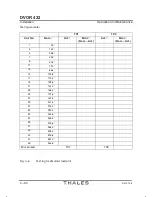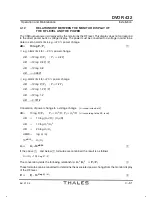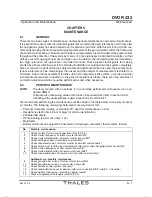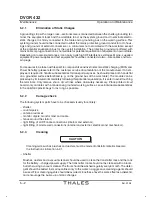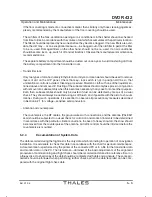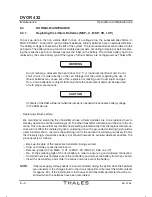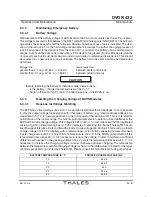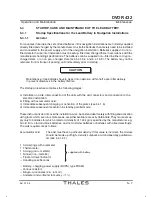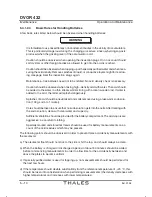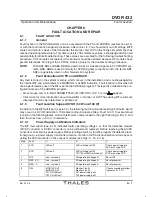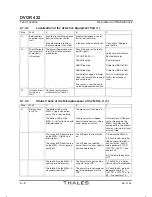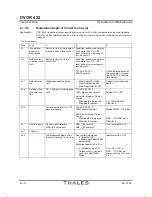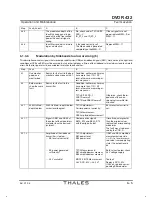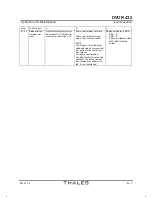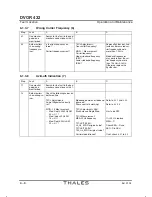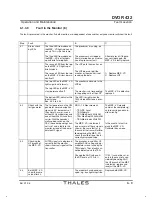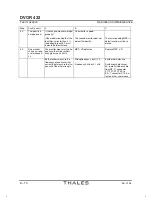
DVOR 432
Maintenance
Operation and Maintenance
5-10
Ed. 01.04
5.4.1.2.4
Basic Rules for Handling Batteries
A few basic rules listed below should be observed when handling batteries:
WARNING
It is forbidden to use naked flames or incandescent bodies in the vicinity of accumulators.
This is particularly dangerous during the charging procedure, since oxyhydrogen gas is
produced when the gassing level of the accumulator acid.
Caution should be observed when opening the inspection plugs. On no account should
salt crystals or other foreign bodies be allowed to get into the acid is reached.
Caution should be observed when topping up with specially purified water and when meaĆ
suring the acid density. Remove splashes of liquid, or conductive layers might form, allowĆ
ing creepage. Seal the inspection plugs again.
Maintenance-free batteries need not to be refilled. No acid density check is necessary.
Caution should be observed when mixing high-density acid with water. The acid should
be added to the water in a thin streamwhilst stirring with a clean wooden rod. If water is
added to the acid, the latter will splash dangerously.
Splashes of acid should be neutralized and salts removed using a lukewarm soda soluĆ
tion (100 g soda to 1 l water).
Care should be taken to ensure that no soda solution gets into the cells. After treating with
the soda solution, clean with clear water and wipe dry.
Sufficient ventilation should be provided for the battery compartment. The acid vapors are
aggressive; be careful of clothing.
Specially marked and stored test leads should be used for battery measurements on acĆ
count of the acid residues which may be present.
The following points should be observed in order to prevent false acid density measurements with
the areometer:
a) The areometer float should not stick to the side or hit the top, and should always be clean.
b) When the battery is charged or discharged a period of about 30 minutes should be waited
before commencing measurements in order to allow time for the acid density between and
above the plates to become uniform.
c) If specially purified water is used for topping up, no measurements should be performed for
the next few hours.
d) If the temperature should deviate substantially from the reference temperature of +20 °C, this
should be taken into consideration when performing measurements (the density decreases with
higher temperatures and increases with lower temperatures).
Summary of Contents for DVOR 432
Page 2: ......
Page 4: ......
Page 16: ...DVOR 432 Table of Contents Operation and Maintenance X Ed 01 04 ...
Page 38: ...DVOR 432 General Information Operation and Maintenance 1 6 Ed 01 04 ...
Page 40: ...DVOR 432 General Information Operation and Maintenance 1 8 Ed 01 04 ...
Page 46: ......
Page 66: ...DVOR 432 Installation Operation and Maintenance 2 24 Ed 01 04 ...
Page 74: ......
Page 136: ...DVOR 432 Installation Operation and Maintenance 4 32 Ed 01 04 ...
Page 172: ...DVOR 432 Repairs Operation and Maintenance 6 22 Ed 01 04 ...
Page 186: ...DVOR 432 Repairs Operation and Maintenance 6 36 Ed 01 04 ...
Page 192: ...DVOR 432 Installation Operation and Maintenance Annex Nextfield AN 4 Ed 01 04 ...
Page 194: ......
Page 196: ...DVOR 432 General Operation and Maintenance Annex Nextfield L 2 Ed 01 04 ...
Page 204: ...DVOR 432 Alignment Procedure Operation and Maintenance Annex Nextfield AN 14 Ed 01 04 ...
Page 234: ...DVOR 432 Maintenance Operation and Maintenance Annex Nextfield AN 44 Ed 01 04 ...



